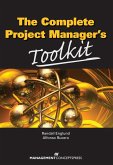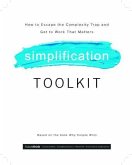D. Joel Whalen
The Professional Communications Toolkit
D. Joel Whalen
The Professional Communications Toolkit
- Broschiertes Buch
- Merkliste
- Auf die Merkliste
- Bewerten Bewerten
- Teilen
- Produkt teilen
- Produkterinnerung
- Produkterinnerung
The Professional Communications Toolkit presents a compelling vision of communication that offers little known and amazingly effective techniques for the novice speaker and stage-savvy pro alike. Author D. Joel Whalen provides practical, research-based tools that apply perfectly to all professional communication, whether it's one-on-one conversations, speaking at small staff meetings, or delivering a keynote address to a ballroom full of people.
Andere Kunden interessierten sich auch für
![Innovative Marketing Communications Innovative Marketing Communications]() Guy MastermanInnovative Marketing Communications78,99 €
Guy MastermanInnovative Marketing Communications78,99 €![The Sports Management Toolkit The Sports Management Toolkit]() Paul EmeryThe Sports Management Toolkit84,99 €
Paul EmeryThe Sports Management Toolkit84,99 €![The Complete Project Manager's Toolkit The Complete Project Manager's Toolkit]() Randall EnglundThe Complete Project Manager's Toolkit40,99 €
Randall EnglundThe Complete Project Manager's Toolkit40,99 €![The Project Manager's Communication Toolkit The Project Manager's Communication Toolkit]() Shankar JhaThe Project Manager's Communication Toolkit84,99 €
Shankar JhaThe Project Manager's Communication Toolkit84,99 €![The Implementation of Professional Management The Implementation of Professional Management]() Rand FredericThe Implementation of Professional Management21,99 €
Rand FredericThe Implementation of Professional Management21,99 €![The Ultimate Leadership Toolkit The Ultimate Leadership Toolkit]() Gaurav JainThe Ultimate Leadership Toolkit23,99 €
Gaurav JainThe Ultimate Leadership Toolkit23,99 €![Why Simple Wins Toolkit Why Simple Wins Toolkit]() Lisa BodellWhy Simple Wins Toolkit87,99 €
Lisa BodellWhy Simple Wins Toolkit87,99 €-
-
-
The Professional Communications Toolkit presents a compelling vision of communication that offers little known and amazingly effective techniques for the novice speaker and stage-savvy pro alike. Author D. Joel Whalen provides practical, research-based tools that apply perfectly to all professional communication, whether it's one-on-one conversations, speaking at small staff meetings, or delivering a keynote address to a ballroom full of people.
Hinweis: Dieser Artikel kann nur an eine deutsche Lieferadresse ausgeliefert werden.
Hinweis: Dieser Artikel kann nur an eine deutsche Lieferadresse ausgeliefert werden.
Produktdetails
- Produktdetails
- Verlag: Sage Publications, Inc
- Seitenzahl: 304
- Erscheinungstermin: 20. Dezember 2006
- Englisch
- Abmessung: 254mm x 178mm x 16mm
- Gewicht: 576g
- ISBN-13: 9781412927161
- ISBN-10: 1412927161
- Artikelnr.: 22218202
- Herstellerkennzeichnung
- Libri GmbH
- Europaallee 1
- 36244 Bad Hersfeld
- gpsr@libri.de
- Verlag: Sage Publications, Inc
- Seitenzahl: 304
- Erscheinungstermin: 20. Dezember 2006
- Englisch
- Abmessung: 254mm x 178mm x 16mm
- Gewicht: 576g
- ISBN-13: 9781412927161
- ISBN-10: 1412927161
- Artikelnr.: 22218202
- Herstellerkennzeichnung
- Libri GmbH
- Europaallee 1
- 36244 Bad Hersfeld
- gpsr@libri.de
Joel Whalen is Academic Director of the Kellstadt Center Sales Leadership Program at Chicagös DePaul University (since 1986). He is an Associate Professor of Marketing and holds a Ph.D. in Marketing Communications (Florida State University '86). Dr. Whalen has been listed by Whös Who in America and Men of Distinction, Cambridge, England. He is a Sales and Sales Management Fellow of the American Marketing Association. The Ernst & Young Entrepreneurship Foundation named him Entrepreneur of the Year, and he is a member of the Entrepreneur Hall of Fame. Joel has received numerous awards for outstanding teaching. After 10 years of study, experimentation, and innovation, in cooperation with companies, associations, and thousands of DePaul students, Joel discovered the core psychological, attitudinal, and behavioral drivers behind effective, professional communication. He created a series of exercises that have helped people become more masterful communicators. In workshops and classes throughout the U.S., Australia, and Thailand, Dr. Whalen gives thousands of people the tools they need. Dr. Whalen has an extensive background in sales and advertising. As a salesperson and sales manager, he consistently set all-time sales records. Joel has received numerous advertising awards for creative television and radio commercials, including an award for one of the first television commercials created by a computer. In Florida politics, Whalen was communications advisor to several successful, statewide political campaigns. Dr. Whalen is the author of I See What You Mean, Sage Publications. He has published articles in: Psychology & Marketing Journal of Business Research Journal of Business Ethics Design Management Journal Journal of Educational & Psychological Measurement Journal of Promotions Management Joel has been interviewed by national and international press including:l CBS NBC ABC PBS NPR's Marketplace Advertising Age Atlanta Constitution Chicago Tribune Chicago Sun Times Christian Science Monitor Financial Times of London Playboy Time The Australian Broadcasting Company (ABC)
Preface Why Communication Is Import Little Help From Science So You Think Yoüre Not Understood? Acknowledgments Chapter 1: Effective Communication:
It
s Not About Yoü What Kind of Communication Do You Need?
Checklist Communication
--Best Done Quickly
Convincing Communication
--Requires More Preparation Dominant and Subordinate Roles Simultaneous Feedback How the Message You Send Gets Meaning Leadership: Communicating Your Vision Seek to Share Understanding
Felt Sense
: Your Body Knows Monkey See, Monkey Communicate--
Mirror Neurons
Chapter 1 Summary Key Ideas Chapter 2: Message Strategies - What to Speak and What to Write:
Attitude in 90% of Speaking
Power of Speaking: Oral Communication The Essence of Communication: Meaning Poor Communication Teaching Before You Speak, Set Your Attitude Speaking Delivers Less Content Nonverbal Communication When You Talk, You Show How You Feel During Great Communication, You Disappear Here
s What Great Attitude Feels Like Most Motivating Emotion = Enthusiasm Communication Toolbox Telephone and Voicemail Techniques First Rule: Yoüre Introducing--Ask for Permission to Speak Telephone: Your
ve Lost 55 Percent of Your Ability to Create Meaning Visualize Your Listener--Imagine Your Unseen Listener When to Leave Your Name and Number Chapter 2 Summary Key Ideas
Communicator
s Checklist
Chapter 3: The Power and Limitations of Speaking Miscommunication Is Common What to Write/What to Say? The Power of Speaking What Was Rememered and What Was Forgotten Your "Self" Was Formed Over Time Some Brain Patterns Are On-Board at Birth Brain Programmed Through Sensory Information Secret Behind Using Sense Memory Sensory Preference--
Different Senses for Different People
Symbols The Basic Element of Communication: The Sign Theatre of the Mind Types of Symbols Denotative Symbols Connotative Symbols Persuasive Messages Contain Both Denotative and Connotative Symbols Contextual Meaning Color Lines Space Subtle Symbols: Power and Confidence Touch Smells Emotions and Fear Persuading Angry People Handling Angry Supervisors and Customers Using Fear to Persuade Fear Messages Can Backfire--Watch Out: "Fear Appeals Must Be Handled Carefully
Buyers
Four Big Fears
The Professional Loser Persuasion Ethics Chapter 3 Summary Key Ideas
Communicator
s Checklist
Chapter 4: When Yoüre Afraid to Communicate:
Understanding Anxiety and Fear
Why Must You Manage Your Speech Anxiety? If You Never Get Communication Anxiety, Yoüre a Rare Bird Communication Anxiety: Silent Enemy of Success Americans
Greatest Phopias When It
s Your Turn to Speak, Do You Get These Symptoms? When Yoüll Get It Strategies When Yoüre Not a
Master of the Message
Communication Toolbox The Thinking Person
s Approach: Understanding the Psychophysiology of Anxiety Anxiety Manufacturing Plant: Your Brain Stem Chapter 4 Summanry Key Ideas
Communicator
s Checklist
Chapter 5: Managing Communication Anxiety:
Action Steps You Can Take
Action Steps You Can Take Some Anxiety Is Good Decide: Is It Fear or Excitement? Don
t Try to Be Cool--You Won
t Look Confident Idle Your Engine Be Here Now
Square Breathing
Calm Down Breathing
Stretch Away Your Tension How to Build a List of
Personal Power Thoughts
Taking Control of Persistent Fears False Alarms Go Off in Your Head Your Brain Stem Is Obsessed With Fear The Deer-in-the-Headlights Look Communication Toolbox Dealing With Balnking Out Two Different Speed Zones--Yours and the Audience
s Blanking Out Under Pressure Know More About How Your Mind Works:
Attribution of Cause
How to Use the Power of Attribution Theory to Manage Speech Anxiety Seven Keys to Managing: Communication Anxiety Advanced Fear Management Getting More Help Medical Management by Corey Goldstein, M.D. What to Do When communication Anxiety is Overwhelming Non-pill Relief A Pill May Help Medications That Ease Communication Anxiety Help Is Available Chapter 5 Summary Key Ideas
Communicator
s Checklist
Chapter 6: Making People Believe You:
Persuasive Communication
First, People Must Believe You--Managing Your Credibility Source Credibility Yoüve Got to Answer Your Listeners
Unasked Questions Credibility and the Team Player Ancient Greeks
Secrets of Credibility
Three Pillars of Credibility
: Expertise, Trustworthiness, and Goodwill The Four Component of Credibility Fluid presentation--Another Type of Dynamism Credibility From the Audience
s Eyes Attribution Theory and Credibility Put Your Credibility to Work Credibility Builders: Some Tricks of the Trade
Wingman
Technique
Wingman
in the Sales Call Yoüre a Product
Wingman
in Job Interviews The Single Most Effective Political commercial Warning: High Credibility Can Backfire on the Professional When High Credibility Can Kill You Credibility and the Business Professional Chapter 6 summary Key Ideas
Communicator
s Checklist
Chapter 7: Message Packaging - Strategies for Formatting Presentations:
How You Say It
Opening the Presentation The
Question Opening
Einstein
s Time Shift
The Power of Brainwashing How to Structure Your Presentation With Questions A Classic Presentation Format--
Tell
Em
The
Cold Closing
No
Thank Yoü Allowed Warning: Don
t Ask for Questions A Perfect Strategy: The
Nichols
s Two-Things
Presentation Write Your Presentation in Five Minutes The Final Format--Presenting as a Tem Member Benefits of Team Presentations Specialty Roles The
Hand-Off
Wingman
in Team Presentations Communication Toolbox
Communicator
s Checklist
Opening the Presentation The
Question Opening
--Four Steps Checklist for Successfully Executing the
Question Opening
Cold Closing
Checklist Specialist Checklist Chapter 7 Summary Key Ideas Chapter 8: Message Delivery -
Performing the Presentation
Yoüre in Showbiz--Entertain
Em Power of Selective Attention Fight Back--Work to Refresh Their Attention Frequently Before You Are Introduced, See If Your Audience Has a Pulse Prepare for the Disaster That Will Never Come Let Your Body Speak for You Projecting Your Attitude to Your Audience Take Charge of the Room Business Presentations Are Not Storytelling Business Presentations Versus Social Presentations Presenting PowerPoint Slides
Turn, Touch, & Tell
Presenting Graphs Communication Toolbox Ten Tips and Rules for Persuasive Presentations Handling the Audience
s Questions Voice Control Chapter 8 Summary Key Ideas
Communicator
s Checklist
Chapter 9: Writing E-mails and Memos With High Communication Factor Busy People Scan Stop Sending Out Rough Drafts Advantage to Written Communication Three Ideas to Get Your E-mails and Memos Read Idea One--Use Typeface and White Space Why People Like Sans Serif Pick Proportional Type Don
t Use Reverse Typeface White Space Directs the Eye Idea Two-Prep Your Reader
s Brain Bullets--When Should You Use Bullets? Bullet FAQs Communication Toolbox E-mail Techniques Starting Your E-mail--What to Write First Subject Lines Essential Elements Idea Three--Motivate Your Reader to Read Memo Writing Rules Writing With High Communication Factor Common Grammatical Errors Editing Tips Writing of Motivation Sentence Chapter 9 Summary Key Ideas
Communicator
s Checklist
Chapter 10: Communicating With Tables, Graphs, and Charts:
Your Visual Toolbox
Tables Graphs--Pictures, Not Words How to Make Tables and Graphs Making Pretty Pie Charts Making Highly Readable Graphs Graph Building Techniques To 3-D or Not to 3-D? That Is the Question Graphs That Deceive Models--Perceptual Maps Choose Your Software Carefully Chapter 10 Summary Key Ideas
Communicator
s Checklist
Chapter 11: Maximum PowerPoint Type Size Typestyle Kepp Punctuation to a Minimum How Much Information to Put on a Slide Communicating With Color Presenting With Visuals When to Hand Out Materials Sample Presentation Visuals Bullets Are Great--Use Them Chapter 11 Summary Key Ideas
Communicator
s Checklist
Demonstration PowerPoint Slide Editing Text Slides On Graphs Appendix: If Yoüd Like to Learn More Recommended Reading Take These Training Courses References Index About the Authors
It
s Not About Yoü What Kind of Communication Do You Need?
Checklist Communication
--Best Done Quickly
Convincing Communication
--Requires More Preparation Dominant and Subordinate Roles Simultaneous Feedback How the Message You Send Gets Meaning Leadership: Communicating Your Vision Seek to Share Understanding
Felt Sense
: Your Body Knows Monkey See, Monkey Communicate--
Mirror Neurons
Chapter 1 Summary Key Ideas Chapter 2: Message Strategies - What to Speak and What to Write:
Attitude in 90% of Speaking
Power of Speaking: Oral Communication The Essence of Communication: Meaning Poor Communication Teaching Before You Speak, Set Your Attitude Speaking Delivers Less Content Nonverbal Communication When You Talk, You Show How You Feel During Great Communication, You Disappear Here
s What Great Attitude Feels Like Most Motivating Emotion = Enthusiasm Communication Toolbox Telephone and Voicemail Techniques First Rule: Yoüre Introducing--Ask for Permission to Speak Telephone: Your
ve Lost 55 Percent of Your Ability to Create Meaning Visualize Your Listener--Imagine Your Unseen Listener When to Leave Your Name and Number Chapter 2 Summary Key Ideas
Communicator
s Checklist
Chapter 3: The Power and Limitations of Speaking Miscommunication Is Common What to Write/What to Say? The Power of Speaking What Was Rememered and What Was Forgotten Your "Self" Was Formed Over Time Some Brain Patterns Are On-Board at Birth Brain Programmed Through Sensory Information Secret Behind Using Sense Memory Sensory Preference--
Different Senses for Different People
Symbols The Basic Element of Communication: The Sign Theatre of the Mind Types of Symbols Denotative Symbols Connotative Symbols Persuasive Messages Contain Both Denotative and Connotative Symbols Contextual Meaning Color Lines Space Subtle Symbols: Power and Confidence Touch Smells Emotions and Fear Persuading Angry People Handling Angry Supervisors and Customers Using Fear to Persuade Fear Messages Can Backfire--Watch Out: "Fear Appeals Must Be Handled Carefully
Buyers
Four Big Fears
The Professional Loser Persuasion Ethics Chapter 3 Summary Key Ideas
Communicator
s Checklist
Chapter 4: When Yoüre Afraid to Communicate:
Understanding Anxiety and Fear
Why Must You Manage Your Speech Anxiety? If You Never Get Communication Anxiety, Yoüre a Rare Bird Communication Anxiety: Silent Enemy of Success Americans
Greatest Phopias When It
s Your Turn to Speak, Do You Get These Symptoms? When Yoüll Get It Strategies When Yoüre Not a
Master of the Message
Communication Toolbox The Thinking Person
s Approach: Understanding the Psychophysiology of Anxiety Anxiety Manufacturing Plant: Your Brain Stem Chapter 4 Summanry Key Ideas
Communicator
s Checklist
Chapter 5: Managing Communication Anxiety:
Action Steps You Can Take
Action Steps You Can Take Some Anxiety Is Good Decide: Is It Fear or Excitement? Don
t Try to Be Cool--You Won
t Look Confident Idle Your Engine Be Here Now
Square Breathing
Calm Down Breathing
Stretch Away Your Tension How to Build a List of
Personal Power Thoughts
Taking Control of Persistent Fears False Alarms Go Off in Your Head Your Brain Stem Is Obsessed With Fear The Deer-in-the-Headlights Look Communication Toolbox Dealing With Balnking Out Two Different Speed Zones--Yours and the Audience
s Blanking Out Under Pressure Know More About How Your Mind Works:
Attribution of Cause
How to Use the Power of Attribution Theory to Manage Speech Anxiety Seven Keys to Managing: Communication Anxiety Advanced Fear Management Getting More Help Medical Management by Corey Goldstein, M.D. What to Do When communication Anxiety is Overwhelming Non-pill Relief A Pill May Help Medications That Ease Communication Anxiety Help Is Available Chapter 5 Summary Key Ideas
Communicator
s Checklist
Chapter 6: Making People Believe You:
Persuasive Communication
First, People Must Believe You--Managing Your Credibility Source Credibility Yoüve Got to Answer Your Listeners
Unasked Questions Credibility and the Team Player Ancient Greeks
Secrets of Credibility
Three Pillars of Credibility
: Expertise, Trustworthiness, and Goodwill The Four Component of Credibility Fluid presentation--Another Type of Dynamism Credibility From the Audience
s Eyes Attribution Theory and Credibility Put Your Credibility to Work Credibility Builders: Some Tricks of the Trade
Wingman
Technique
Wingman
in the Sales Call Yoüre a Product
Wingman
in Job Interviews The Single Most Effective Political commercial Warning: High Credibility Can Backfire on the Professional When High Credibility Can Kill You Credibility and the Business Professional Chapter 6 summary Key Ideas
Communicator
s Checklist
Chapter 7: Message Packaging - Strategies for Formatting Presentations:
How You Say It
Opening the Presentation The
Question Opening
Einstein
s Time Shift
The Power of Brainwashing How to Structure Your Presentation With Questions A Classic Presentation Format--
Tell
Em
The
Cold Closing
No
Thank Yoü Allowed Warning: Don
t Ask for Questions A Perfect Strategy: The
Nichols
s Two-Things
Presentation Write Your Presentation in Five Minutes The Final Format--Presenting as a Tem Member Benefits of Team Presentations Specialty Roles The
Hand-Off
Wingman
in Team Presentations Communication Toolbox
Communicator
s Checklist
Opening the Presentation The
Question Opening
--Four Steps Checklist for Successfully Executing the
Question Opening
Cold Closing
Checklist Specialist Checklist Chapter 7 Summary Key Ideas Chapter 8: Message Delivery -
Performing the Presentation
Yoüre in Showbiz--Entertain
Em Power of Selective Attention Fight Back--Work to Refresh Their Attention Frequently Before You Are Introduced, See If Your Audience Has a Pulse Prepare for the Disaster That Will Never Come Let Your Body Speak for You Projecting Your Attitude to Your Audience Take Charge of the Room Business Presentations Are Not Storytelling Business Presentations Versus Social Presentations Presenting PowerPoint Slides
Turn, Touch, & Tell
Presenting Graphs Communication Toolbox Ten Tips and Rules for Persuasive Presentations Handling the Audience
s Questions Voice Control Chapter 8 Summary Key Ideas
Communicator
s Checklist
Chapter 9: Writing E-mails and Memos With High Communication Factor Busy People Scan Stop Sending Out Rough Drafts Advantage to Written Communication Three Ideas to Get Your E-mails and Memos Read Idea One--Use Typeface and White Space Why People Like Sans Serif Pick Proportional Type Don
t Use Reverse Typeface White Space Directs the Eye Idea Two-Prep Your Reader
s Brain Bullets--When Should You Use Bullets? Bullet FAQs Communication Toolbox E-mail Techniques Starting Your E-mail--What to Write First Subject Lines Essential Elements Idea Three--Motivate Your Reader to Read Memo Writing Rules Writing With High Communication Factor Common Grammatical Errors Editing Tips Writing of Motivation Sentence Chapter 9 Summary Key Ideas
Communicator
s Checklist
Chapter 10: Communicating With Tables, Graphs, and Charts:
Your Visual Toolbox
Tables Graphs--Pictures, Not Words How to Make Tables and Graphs Making Pretty Pie Charts Making Highly Readable Graphs Graph Building Techniques To 3-D or Not to 3-D? That Is the Question Graphs That Deceive Models--Perceptual Maps Choose Your Software Carefully Chapter 10 Summary Key Ideas
Communicator
s Checklist
Chapter 11: Maximum PowerPoint Type Size Typestyle Kepp Punctuation to a Minimum How Much Information to Put on a Slide Communicating With Color Presenting With Visuals When to Hand Out Materials Sample Presentation Visuals Bullets Are Great--Use Them Chapter 11 Summary Key Ideas
Communicator
s Checklist
Demonstration PowerPoint Slide Editing Text Slides On Graphs Appendix: If Yoüd Like to Learn More Recommended Reading Take These Training Courses References Index About the Authors
Preface Why Communication Is Import Little Help From Science So You Think Yoüre Not Understood? Acknowledgments Chapter 1: Effective Communication:
It
s Not About Yoü What Kind of Communication Do You Need?
Checklist Communication
--Best Done Quickly
Convincing Communication
--Requires More Preparation Dominant and Subordinate Roles Simultaneous Feedback How the Message You Send Gets Meaning Leadership: Communicating Your Vision Seek to Share Understanding
Felt Sense
: Your Body Knows Monkey See, Monkey Communicate--
Mirror Neurons
Chapter 1 Summary Key Ideas Chapter 2: Message Strategies - What to Speak and What to Write:
Attitude in 90% of Speaking
Power of Speaking: Oral Communication The Essence of Communication: Meaning Poor Communication Teaching Before You Speak, Set Your Attitude Speaking Delivers Less Content Nonverbal Communication When You Talk, You Show How You Feel During Great Communication, You Disappear Here
s What Great Attitude Feels Like Most Motivating Emotion = Enthusiasm Communication Toolbox Telephone and Voicemail Techniques First Rule: Yoüre Introducing--Ask for Permission to Speak Telephone: Your
ve Lost 55 Percent of Your Ability to Create Meaning Visualize Your Listener--Imagine Your Unseen Listener When to Leave Your Name and Number Chapter 2 Summary Key Ideas
Communicator
s Checklist
Chapter 3: The Power and Limitations of Speaking Miscommunication Is Common What to Write/What to Say? The Power of Speaking What Was Rememered and What Was Forgotten Your "Self" Was Formed Over Time Some Brain Patterns Are On-Board at Birth Brain Programmed Through Sensory Information Secret Behind Using Sense Memory Sensory Preference--
Different Senses for Different People
Symbols The Basic Element of Communication: The Sign Theatre of the Mind Types of Symbols Denotative Symbols Connotative Symbols Persuasive Messages Contain Both Denotative and Connotative Symbols Contextual Meaning Color Lines Space Subtle Symbols: Power and Confidence Touch Smells Emotions and Fear Persuading Angry People Handling Angry Supervisors and Customers Using Fear to Persuade Fear Messages Can Backfire--Watch Out: "Fear Appeals Must Be Handled Carefully
Buyers
Four Big Fears
The Professional Loser Persuasion Ethics Chapter 3 Summary Key Ideas
Communicator
s Checklist
Chapter 4: When Yoüre Afraid to Communicate:
Understanding Anxiety and Fear
Why Must You Manage Your Speech Anxiety? If You Never Get Communication Anxiety, Yoüre a Rare Bird Communication Anxiety: Silent Enemy of Success Americans
Greatest Phopias When It
s Your Turn to Speak, Do You Get These Symptoms? When Yoüll Get It Strategies When Yoüre Not a
Master of the Message
Communication Toolbox The Thinking Person
s Approach: Understanding the Psychophysiology of Anxiety Anxiety Manufacturing Plant: Your Brain Stem Chapter 4 Summanry Key Ideas
Communicator
s Checklist
Chapter 5: Managing Communication Anxiety:
Action Steps You Can Take
Action Steps You Can Take Some Anxiety Is Good Decide: Is It Fear or Excitement? Don
t Try to Be Cool--You Won
t Look Confident Idle Your Engine Be Here Now
Square Breathing
Calm Down Breathing
Stretch Away Your Tension How to Build a List of
Personal Power Thoughts
Taking Control of Persistent Fears False Alarms Go Off in Your Head Your Brain Stem Is Obsessed With Fear The Deer-in-the-Headlights Look Communication Toolbox Dealing With Balnking Out Two Different Speed Zones--Yours and the Audience
s Blanking Out Under Pressure Know More About How Your Mind Works:
Attribution of Cause
How to Use the Power of Attribution Theory to Manage Speech Anxiety Seven Keys to Managing: Communication Anxiety Advanced Fear Management Getting More Help Medical Management by Corey Goldstein, M.D. What to Do When communication Anxiety is Overwhelming Non-pill Relief A Pill May Help Medications That Ease Communication Anxiety Help Is Available Chapter 5 Summary Key Ideas
Communicator
s Checklist
Chapter 6: Making People Believe You:
Persuasive Communication
First, People Must Believe You--Managing Your Credibility Source Credibility Yoüve Got to Answer Your Listeners
Unasked Questions Credibility and the Team Player Ancient Greeks
Secrets of Credibility
Three Pillars of Credibility
: Expertise, Trustworthiness, and Goodwill The Four Component of Credibility Fluid presentation--Another Type of Dynamism Credibility From the Audience
s Eyes Attribution Theory and Credibility Put Your Credibility to Work Credibility Builders: Some Tricks of the Trade
Wingman
Technique
Wingman
in the Sales Call Yoüre a Product
Wingman
in Job Interviews The Single Most Effective Political commercial Warning: High Credibility Can Backfire on the Professional When High Credibility Can Kill You Credibility and the Business Professional Chapter 6 summary Key Ideas
Communicator
s Checklist
Chapter 7: Message Packaging - Strategies for Formatting Presentations:
How You Say It
Opening the Presentation The
Question Opening
Einstein
s Time Shift
The Power of Brainwashing How to Structure Your Presentation With Questions A Classic Presentation Format--
Tell
Em
The
Cold Closing
No
Thank Yoü Allowed Warning: Don
t Ask for Questions A Perfect Strategy: The
Nichols
s Two-Things
Presentation Write Your Presentation in Five Minutes The Final Format--Presenting as a Tem Member Benefits of Team Presentations Specialty Roles The
Hand-Off
Wingman
in Team Presentations Communication Toolbox
Communicator
s Checklist
Opening the Presentation The
Question Opening
--Four Steps Checklist for Successfully Executing the
Question Opening
Cold Closing
Checklist Specialist Checklist Chapter 7 Summary Key Ideas Chapter 8: Message Delivery -
Performing the Presentation
Yoüre in Showbiz--Entertain
Em Power of Selective Attention Fight Back--Work to Refresh Their Attention Frequently Before You Are Introduced, See If Your Audience Has a Pulse Prepare for the Disaster That Will Never Come Let Your Body Speak for You Projecting Your Attitude to Your Audience Take Charge of the Room Business Presentations Are Not Storytelling Business Presentations Versus Social Presentations Presenting PowerPoint Slides
Turn, Touch, & Tell
Presenting Graphs Communication Toolbox Ten Tips and Rules for Persuasive Presentations Handling the Audience
s Questions Voice Control Chapter 8 Summary Key Ideas
Communicator
s Checklist
Chapter 9: Writing E-mails and Memos With High Communication Factor Busy People Scan Stop Sending Out Rough Drafts Advantage to Written Communication Three Ideas to Get Your E-mails and Memos Read Idea One--Use Typeface and White Space Why People Like Sans Serif Pick Proportional Type Don
t Use Reverse Typeface White Space Directs the Eye Idea Two-Prep Your Reader
s Brain Bullets--When Should You Use Bullets? Bullet FAQs Communication Toolbox E-mail Techniques Starting Your E-mail--What to Write First Subject Lines Essential Elements Idea Three--Motivate Your Reader to Read Memo Writing Rules Writing With High Communication Factor Common Grammatical Errors Editing Tips Writing of Motivation Sentence Chapter 9 Summary Key Ideas
Communicator
s Checklist
Chapter 10: Communicating With Tables, Graphs, and Charts:
Your Visual Toolbox
Tables Graphs--Pictures, Not Words How to Make Tables and Graphs Making Pretty Pie Charts Making Highly Readable Graphs Graph Building Techniques To 3-D or Not to 3-D? That Is the Question Graphs That Deceive Models--Perceptual Maps Choose Your Software Carefully Chapter 10 Summary Key Ideas
Communicator
s Checklist
Chapter 11: Maximum PowerPoint Type Size Typestyle Kepp Punctuation to a Minimum How Much Information to Put on a Slide Communicating With Color Presenting With Visuals When to Hand Out Materials Sample Presentation Visuals Bullets Are Great--Use Them Chapter 11 Summary Key Ideas
Communicator
s Checklist
Demonstration PowerPoint Slide Editing Text Slides On Graphs Appendix: If Yoüd Like to Learn More Recommended Reading Take These Training Courses References Index About the Authors
It
s Not About Yoü What Kind of Communication Do You Need?
Checklist Communication
--Best Done Quickly
Convincing Communication
--Requires More Preparation Dominant and Subordinate Roles Simultaneous Feedback How the Message You Send Gets Meaning Leadership: Communicating Your Vision Seek to Share Understanding
Felt Sense
: Your Body Knows Monkey See, Monkey Communicate--
Mirror Neurons
Chapter 1 Summary Key Ideas Chapter 2: Message Strategies - What to Speak and What to Write:
Attitude in 90% of Speaking
Power of Speaking: Oral Communication The Essence of Communication: Meaning Poor Communication Teaching Before You Speak, Set Your Attitude Speaking Delivers Less Content Nonverbal Communication When You Talk, You Show How You Feel During Great Communication, You Disappear Here
s What Great Attitude Feels Like Most Motivating Emotion = Enthusiasm Communication Toolbox Telephone and Voicemail Techniques First Rule: Yoüre Introducing--Ask for Permission to Speak Telephone: Your
ve Lost 55 Percent of Your Ability to Create Meaning Visualize Your Listener--Imagine Your Unseen Listener When to Leave Your Name and Number Chapter 2 Summary Key Ideas
Communicator
s Checklist
Chapter 3: The Power and Limitations of Speaking Miscommunication Is Common What to Write/What to Say? The Power of Speaking What Was Rememered and What Was Forgotten Your "Self" Was Formed Over Time Some Brain Patterns Are On-Board at Birth Brain Programmed Through Sensory Information Secret Behind Using Sense Memory Sensory Preference--
Different Senses for Different People
Symbols The Basic Element of Communication: The Sign Theatre of the Mind Types of Symbols Denotative Symbols Connotative Symbols Persuasive Messages Contain Both Denotative and Connotative Symbols Contextual Meaning Color Lines Space Subtle Symbols: Power and Confidence Touch Smells Emotions and Fear Persuading Angry People Handling Angry Supervisors and Customers Using Fear to Persuade Fear Messages Can Backfire--Watch Out: "Fear Appeals Must Be Handled Carefully
Buyers
Four Big Fears
The Professional Loser Persuasion Ethics Chapter 3 Summary Key Ideas
Communicator
s Checklist
Chapter 4: When Yoüre Afraid to Communicate:
Understanding Anxiety and Fear
Why Must You Manage Your Speech Anxiety? If You Never Get Communication Anxiety, Yoüre a Rare Bird Communication Anxiety: Silent Enemy of Success Americans
Greatest Phopias When It
s Your Turn to Speak, Do You Get These Symptoms? When Yoüll Get It Strategies When Yoüre Not a
Master of the Message
Communication Toolbox The Thinking Person
s Approach: Understanding the Psychophysiology of Anxiety Anxiety Manufacturing Plant: Your Brain Stem Chapter 4 Summanry Key Ideas
Communicator
s Checklist
Chapter 5: Managing Communication Anxiety:
Action Steps You Can Take
Action Steps You Can Take Some Anxiety Is Good Decide: Is It Fear or Excitement? Don
t Try to Be Cool--You Won
t Look Confident Idle Your Engine Be Here Now
Square Breathing
Calm Down Breathing
Stretch Away Your Tension How to Build a List of
Personal Power Thoughts
Taking Control of Persistent Fears False Alarms Go Off in Your Head Your Brain Stem Is Obsessed With Fear The Deer-in-the-Headlights Look Communication Toolbox Dealing With Balnking Out Two Different Speed Zones--Yours and the Audience
s Blanking Out Under Pressure Know More About How Your Mind Works:
Attribution of Cause
How to Use the Power of Attribution Theory to Manage Speech Anxiety Seven Keys to Managing: Communication Anxiety Advanced Fear Management Getting More Help Medical Management by Corey Goldstein, M.D. What to Do When communication Anxiety is Overwhelming Non-pill Relief A Pill May Help Medications That Ease Communication Anxiety Help Is Available Chapter 5 Summary Key Ideas
Communicator
s Checklist
Chapter 6: Making People Believe You:
Persuasive Communication
First, People Must Believe You--Managing Your Credibility Source Credibility Yoüve Got to Answer Your Listeners
Unasked Questions Credibility and the Team Player Ancient Greeks
Secrets of Credibility
Three Pillars of Credibility
: Expertise, Trustworthiness, and Goodwill The Four Component of Credibility Fluid presentation--Another Type of Dynamism Credibility From the Audience
s Eyes Attribution Theory and Credibility Put Your Credibility to Work Credibility Builders: Some Tricks of the Trade
Wingman
Technique
Wingman
in the Sales Call Yoüre a Product
Wingman
in Job Interviews The Single Most Effective Political commercial Warning: High Credibility Can Backfire on the Professional When High Credibility Can Kill You Credibility and the Business Professional Chapter 6 summary Key Ideas
Communicator
s Checklist
Chapter 7: Message Packaging - Strategies for Formatting Presentations:
How You Say It
Opening the Presentation The
Question Opening
Einstein
s Time Shift
The Power of Brainwashing How to Structure Your Presentation With Questions A Classic Presentation Format--
Tell
Em
The
Cold Closing
No
Thank Yoü Allowed Warning: Don
t Ask for Questions A Perfect Strategy: The
Nichols
s Two-Things
Presentation Write Your Presentation in Five Minutes The Final Format--Presenting as a Tem Member Benefits of Team Presentations Specialty Roles The
Hand-Off
Wingman
in Team Presentations Communication Toolbox
Communicator
s Checklist
Opening the Presentation The
Question Opening
--Four Steps Checklist for Successfully Executing the
Question Opening
Cold Closing
Checklist Specialist Checklist Chapter 7 Summary Key Ideas Chapter 8: Message Delivery -
Performing the Presentation
Yoüre in Showbiz--Entertain
Em Power of Selective Attention Fight Back--Work to Refresh Their Attention Frequently Before You Are Introduced, See If Your Audience Has a Pulse Prepare for the Disaster That Will Never Come Let Your Body Speak for You Projecting Your Attitude to Your Audience Take Charge of the Room Business Presentations Are Not Storytelling Business Presentations Versus Social Presentations Presenting PowerPoint Slides
Turn, Touch, & Tell
Presenting Graphs Communication Toolbox Ten Tips and Rules for Persuasive Presentations Handling the Audience
s Questions Voice Control Chapter 8 Summary Key Ideas
Communicator
s Checklist
Chapter 9: Writing E-mails and Memos With High Communication Factor Busy People Scan Stop Sending Out Rough Drafts Advantage to Written Communication Three Ideas to Get Your E-mails and Memos Read Idea One--Use Typeface and White Space Why People Like Sans Serif Pick Proportional Type Don
t Use Reverse Typeface White Space Directs the Eye Idea Two-Prep Your Reader
s Brain Bullets--When Should You Use Bullets? Bullet FAQs Communication Toolbox E-mail Techniques Starting Your E-mail--What to Write First Subject Lines Essential Elements Idea Three--Motivate Your Reader to Read Memo Writing Rules Writing With High Communication Factor Common Grammatical Errors Editing Tips Writing of Motivation Sentence Chapter 9 Summary Key Ideas
Communicator
s Checklist
Chapter 10: Communicating With Tables, Graphs, and Charts:
Your Visual Toolbox
Tables Graphs--Pictures, Not Words How to Make Tables and Graphs Making Pretty Pie Charts Making Highly Readable Graphs Graph Building Techniques To 3-D or Not to 3-D? That Is the Question Graphs That Deceive Models--Perceptual Maps Choose Your Software Carefully Chapter 10 Summary Key Ideas
Communicator
s Checklist
Chapter 11: Maximum PowerPoint Type Size Typestyle Kepp Punctuation to a Minimum How Much Information to Put on a Slide Communicating With Color Presenting With Visuals When to Hand Out Materials Sample Presentation Visuals Bullets Are Great--Use Them Chapter 11 Summary Key Ideas
Communicator
s Checklist
Demonstration PowerPoint Slide Editing Text Slides On Graphs Appendix: If Yoüd Like to Learn More Recommended Reading Take These Training Courses References Index About the Authors








